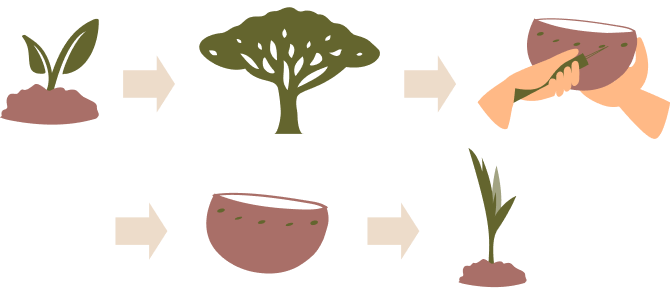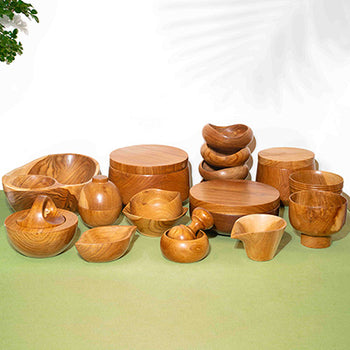From Tree, To Table, To Compost
Sustainable forestry is important to the economies in developing countries and has been threaded into the culture, homes, and livelihoods of various regions for centuries. We understand and condemn excessive logging and the malpractices that surround this activity around the world. As a business, we aim to be in a position where we minimize harm to the environment and contribute to the development of rural economies and livelihoods.


So why trees? Trees are Mother Nature’s ultimate canvas. It holds the history of the world, provides food and shelter to wildlife, regulates the earth’s temperature, and gives us air to breathe. It’s a finite resource with high global demand, and is also one of the best compostable materials with a number of uses. When done right, wood products go from tree, to home, to compost—a full, Earth-friendly cycle that doesn’t diminish the value of trees but enhances it.
As governments, cooperatives, and farmer communities continue to work together to protect and preserve native forests, we know that our best role is to work closely with artisans whose livelihoods and cultures are connected to this industry. We are far from perfect but we are committed to our partners and we are serious about our eco mission. We are continuously learning, growing, and seeking more equitable solutions. There’s a lot more to do to make forestry safer and more sustainable. Until then, we will continue to hold ourselves accountable and practice social responsibility in all our processes.
Our Wood Materials
Coconut Shells & Coconut Wood
- Fast growing coconut trees can yield 80 coconuts per year, which could make 80 bowls
- Coconut wood offcuts can make 200+ plates, utensils, and bowls
- Wood characteristics: Medium to dark brown, quill-like graining, highly versatile—coconut timber can be used for homeware, furniture, construction, firewood, and even gardening


Bamboo
- Bamboo takes only 3-5 years to fully mature
- One of the most dense yet flexible wood materials; its delicate fibers can be used for weaving baskets, bags, and other artisanal goods
- Wood characteristics: Yellow to brown grain coloring, natural earthy odor even after drying, inexpensive and accessible
Acacia Wood
- One of the best hardwood materials—up to 55% harder than European white oak and 23% harder than hickory
- Tolerant to a variety of soil types, making it easy to plant and multiply anywhere
- Wood characteristics: Deep brown patterns, naturally water- and fungus-resistant, great as dinnerware pieces


Olive Wood
- Native to the Mediterranean coast, full of rich historical and cultural significance in the region
- All-around crop; the fruit, leaves, and wood are all useful
- Wood characteristics: Intricate and contrasting graining, naturally resistant to rot and insects, highly durable even with heavy use
Teak Wood
- One of the best water-resistant wood materials
- Protected and highly regulated to ensure its survival
- Wood characteristics: Golden to medium brown graining, highly resistant to decay, best used for furniture, construction, and other heavy-duty homewares

